Sacral neuromodulation blocks pudendal inhibition of reflex bladder activity in cats: insight into the efficacy of sacral neuromodulation in Fowler's syndrome
- PMID: 28931549
- PMCID: PMC5866366
- DOI: 10.1152/ajpregu.00285.2017
Sacral neuromodulation blocks pudendal inhibition of reflex bladder activity in cats: insight into the efficacy of sacral neuromodulation in Fowler's syndrome
Abstract
This study tested the hypothesis that sacral neuromodulation, i.e., electrical stimulation of afferent axons in sacral spinal root, can block pudendal afferent inhibition of the micturition reflex. In α-chloralose-anesthetized cats, pudendal nerve stimulation (PNS) at 3-5 Hz was used to inhibit bladder reflex activity while the sacral S1 or S2 dorsal root was stimulated at 15-30 Hz to mimic sacral neuromodulation and to block the bladder inhibition induced by PNS. The intensity threshold (T) for PNS or S1/S2 dorsal root stimulation (DRS) to induce muscle twitch of anal sphincter or toe was determined. PNS at 1.5-2T intensity inhibited the micturition reflex by significantly ( P < 0.01) increasing bladder capacity to 150-170% of control capacity. S1 DRS alone at 1-1.5T intensity did not inhibit bladder activity but completely blocked PNS inhibition and restored bladder capacity to control level. At higher intensity (1.5-2T), S1 DRS alone inhibited the micturition reflex and significantly increased bladder capacity to 135.8 ± 6.6% of control capacity. However, the same higher intensity S1 DRS applied simultaneously with PNS, suppressed PNS inhibition and significantly ( P < 0.01) reduced bladder capacity to 126.8 ± 9.7% of control capacity. S2 DRS at both low (1T) and high (1.5-2T) intensity failed to significantly reduce PNS inhibition. PNS and S1 DRS did not change the amplitude and duration of micturition reflex contractions, but S2 DRS at 1.5-2T intensity doubled the duration of the contractions and increased bladder capacity. These results are important for understanding the mechanisms underlying sacral neuromodulation of nonobstructive urinary retention in Fowler's syndrome.
Keywords: bladder; cat; neuromodulation; pudendal; sacral.
Figures
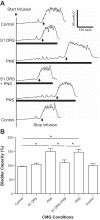

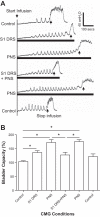
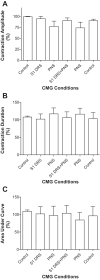
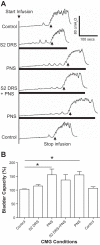

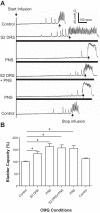
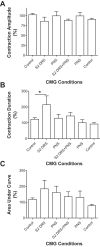
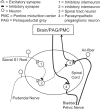
Similar articles
-
Fowler's Syndrome-The Cause of Urinary Retention in Young Women, Often Forgotten, but Significant and Challenging to Treat.Int J Environ Res Public Health. 2021 Mar 23;18(6):3310. doi: 10.3390/ijerph18063310. Int J Environ Res Public Health. 2021. PMID: 33806865 Free PMC article. Review.
-
Bladder underactivity induced by prolonged pudendal afferent activity in cats.Am J Physiol Regul Integr Comp Physiol. 2021 Jan 1;320(1):R80-R87. doi: 10.1152/ajpregu.00239.2020. Epub 2020 Nov 4. Am J Physiol Regul Integr Comp Physiol. 2021. PMID: 33146553 Free PMC article.
-
Effects of stimulation site and stimulation parameters on bladder inhibition by electrical nerve stimulation.BJU Int. 2012 Jul;110(1):136-43. doi: 10.1111/j.1464-410X.2011.10789.x. Epub 2012 Jan 19. BJU Int. 2012. PMID: 22260212
-
Propranolol, but not naloxone, enhances spinal reflex bladder activity and reduces pudendal inhibition in cats.Am J Physiol Regul Integr Comp Physiol. 2015 Jan 1;308(1):R42-9. doi: 10.1152/ajpregu.00368.2014. Epub 2014 Nov 12. Am J Physiol Regul Integr Comp Physiol. 2015. PMID: 25394827 Free PMC article.
-
Continence and micturition: an anatomical basis.Clin Anat. 2014 Nov;27(8):1275-83. doi: 10.1002/ca.22388. Epub 2014 Mar 10. Clin Anat. 2014. PMID: 24615792 Review.
Cited by
-
Frequency-Dependent Effects on Bladder Reflex by Saphenous Nerve Stimulation and a Possible Action Mechanism of Tibial Nerve Stimulation in Cats.Int Neurourol J. 2021 Jun;25(2):128-136. doi: 10.5213/inj.2040304.152. Epub 2021 Feb 4. Int Neurourol J. 2021. PMID: 33561917 Free PMC article.
-
Fowler's Syndrome-The Cause of Urinary Retention in Young Women, Often Forgotten, but Significant and Challenging to Treat.Int J Environ Res Public Health. 2021 Mar 23;18(6):3310. doi: 10.3390/ijerph18063310. Int J Environ Res Public Health. 2021. PMID: 33806865 Free PMC article. Review.
-
Sacral neuromodulation of bladder underactivity induced by prolonged pudendal afferent firing in cats.Am J Physiol Regul Integr Comp Physiol. 2022 Jun 1;322(6):R535-R541. doi: 10.1152/ajpregu.00012.2022. Epub 2022 Mar 23. Am J Physiol Regul Integr Comp Physiol. 2022. PMID: 35319898 Free PMC article.
-
Superficial peroneal neuromodulation of persistent bladder underactivity induced by prolonged pudendal afferent nerve stimulation in cats.Am J Physiol Regul Integr Comp Physiol. 2021 May 1;320(5):R675-R682. doi: 10.1152/ajpregu.00346.2020. Epub 2021 Mar 10. Am J Physiol Regul Integr Comp Physiol. 2021. PMID: 33719564 Free PMC article.
-
Bladder underactivity after prolonged stimulation of somatic afferent axons in the tibial nerve in cats.Neurourol Urodyn. 2018 Sep;37(7):2121-2127. doi: 10.1002/nau.23577. Epub 2018 Apr 10. Neurourol Urodyn. 2018. PMID: 29635834 Free PMC article.
References
-
- de Groat WC, Fraser MO, Yoshiyama M, Smerin S, Tai C, Chancellor MB, Yoshimura N, Roppolo JR. Neural control of the urethra. Scand J Urol Nephrol Suppl 207: 35–43, 2001. - PubMed
Publication types
MeSH terms
Grants and funding
LinkOut - more resources
Full Text Sources
Other Literature Sources
Medical
Molecular Biology Databases
Miscellaneous

